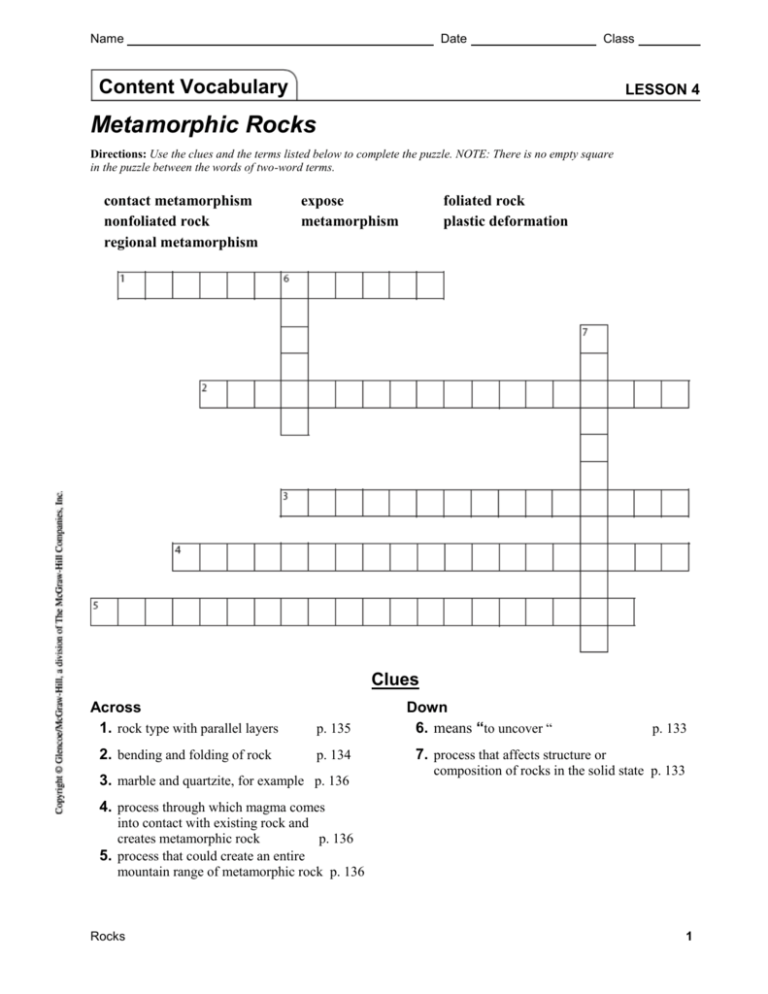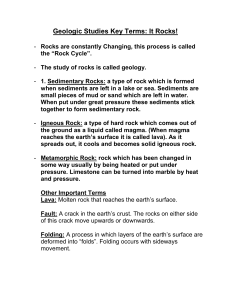Metamorphic Rocks Worksheet: Vocabulary & Key Concepts
advertisement

Name Date Class Content Vocabulary LESSON 4 Metamorphic Rocks Directions: Use the clues and the terms listed below to complete the puzzle. NOTE: There is no empty square in the puzzle between the words of two-word terms. contact metamorphism nonfoliated rock regional metamorphism expose metamorphism foliated rock plastic deformation Clues Across 1. rock type with parallel layers p. 135 2. bending and folding of rock p. 134 3. marble and quartzite, for example p. 136 Down 6. means “to uncover “ p. 133 7. process that affects structure or composition of rocks in the solid state p. 133 4. process through which magma comes into contact with existing rock and creates metamorphic rock p. 136 5. process that could create an entire mountain range of metamorphic rock p. 136 Rocks 1 Name Date Class Content Practice B LESSON 4 Metamorphic Rocks Directions: Answer each question in the space provided. Question Which type of metamorphic rock has a random grain texture? p. 135 Answer 1. Which type of metamorphism results in rocks that 2. are hundreds of square kilometers in size? p. 136 What stays the same in metamorphic rock although mineral composition might change? 3. In which type of metamorphism does magma come into contact with existing rock? p. 136 4. Which two changes in rock give an indication that the rock has undergone metamorphism? p. 134 5. What increases with depth in Earth’s crust and mantle? p. 134 6. What affects the temperatures required to metamorphose rock? p. 134 7. Chemical composition What is the term for the process that causes a 8. permanent change in shape by bending and folding? p. 134 Which type of metamorphism can create an entire 9. mountain range? p. 136 Which type of metamorphism can cause a rock to 10. change by increasing the crystal size or form a completely different mineral? p. 136 How can materials contained in the parallel layers 11. of foliated rocks be described? p. 135 What do geologists study to determine the pressure and temperature at which metamorphic rock formed? p. 134 What is the classification of metamorphic rocks based on? p. 135 2 12. Mineral content 13. Rocks Name Date Class Key Concept Builder Sedimentary Rocks LESSON 3 See purple book pg. 126 Key Concept How do sedimentary rocks form? Directions: Use the picture on pg 126 and the diagram above to answer questions 1-3. 1. Which process has occurred between diagrams A and B? 2. Which process has occurred between diagrams B and C? 3. How do sedimentary rocks form? Use the processes above in your answer. Directions: Answer each question in the space provided. Cause Effect What effect do water and air have on rock? p. 126 4. What happens when rock is physically or chemically changed? p. 126 5. What happens when water travels through rock? p. 126 6. What happens to rock fragments that are carried to new locations by water, glaciers, or wind? p. 126 7. Rocks 3 Name Date Class Key Concept Builder Sedimentary Rocks LESSON 3 See purple book pp. 127-129 Key Concept What are the three types of sedimentary rocks? Directions: On the line before each description, write the letter of the type of rock that matches it correctly. A. clastic rock B. chemical rock C. Organic / biochemical rock 1. made from broken pieces called clasts 2. made from minerals that crystallize directly from water 3. begins with dissolved minerals entering the ocean 4. was formed by or contains the remains of organisms 5. Chert is most often an example of this type of rock. 6. Breccia is an example of this type of rock. 7. begins with water flowing through cracks or empty spaces on rock 8. forms from animal hard parts that compact 9. Rock salt is an example of this type of rock. 10. becomes rounded as they are transported 11. classified by size and shape 12. starts with removing silicon and oxygen from seawater 13. Conglomerate is an example of this type of rock. 14. Coal is an example of this type of rock. 15. Force and an erosional element determined its size and shape. 16. Rock gypsum is an example of this type of rock. 17. Its name in Greek means “broken.” 18. can be made up of large sediment pieces 4 Rocks Name Date Class Key Concept Builder LESSON 2 Igneous Rocks Key Concept How do igneous rocks form? Directions: Answer each question in the space provided. Igneous Rock Formation 1. What three factors are used to determine the type of igneous rock that forms? p. 122 _________________________________________________________ _________________________________________________________ _________________________________________________________ Extrusive Igneous Rock 2. Where does extrusive rock form? 5 Intrusive Igneous Rock p. 120 7. Where does intrusive rock form? p. 121 3. At what rate does extrusive rock cool? p. 120 8. At what rate does intrusive rock cool? p. 121 4. Why don’t crystals always form in extrusive rock? p. 120 9. Why does magma cool at a different rate underground than at the surface? p. 121 5. What happens to the gas in gas-rich lava as it erupts? p. 120 10. Which type of crystals form in intrusive rock? p. 121 6. Which feature of extrusive rock indicates that gases escaped? p. 120 11. How are crystals arranged in intrusive rock? p. 121 Rocks Name Date Key Concept Builder Class LESSON 2 Igneous Rocks Key Concept How do igneous rocks form? Directions: Answer each question in the space provided. Use complete sentences. Question Answer What is the difference between magma and lava? p. 119 1. What moves magma to Earth’s surface? pp. 119-120 2. Which type of rock forms when magma cools underground? pp. 120-121 3. Where is pumice present? 4. p. 120 Why doesn’t obsidian have crystals? p. 120 5. How does basalt form? 6. See table on p. 122 Why is volcanic ash extrusive igneous rock? 7. p. 120 What effect does the rate that magma cools have on crystal formation? 8. pp. 120-121 6 Rocks Name Date Class Key Concept Builder Igneous Rocks LESSON 2 See purple book pp. 120-122 Key Concept What are the common types of igneous rocks? Directions: Put an X in the space(s) that identifies the correct type of igneous rock. May check both on some. Some have already been done for you. Facts Used to Classify Igneous Rock Intrusive Rock Extrusive Rock 1. The crystals in the rock are small or impossible to see with the unaided eye. pp. 120-121 2. The rock has a high amount of silica. p. 122 3. The rock appears to be fine-grained. pp. 120-121 X 4. The rock shows an interlocking texture of crystals. pp. 120-121 5. There might be some quartz present in the rock. p. 122 X X 6. The rock is darker in color. X X p. 122 7. The escape of gas and rapid cooling leave holes in some rocks. pp. 120-121 8. The rock has a low amount of silica. p. 122 X 9. The rock has a rough texture and has holes in it. pp. 120-121 10. The rock appears to be coarse-grained. pp. 120-121 11. The texture of the rock is smooth like glass. pp. 120-121 12. The rock is light in color. p. 122 X 13. The rock is rich in silica. p. 122 X 14. There are no apparent crystals. pp. 120-121 15. There are well-defined crystals. pp. 120-121 7







